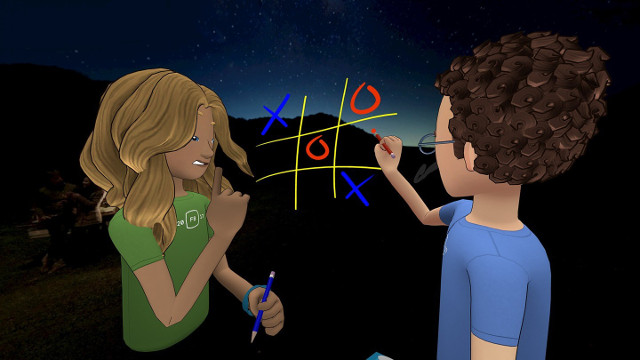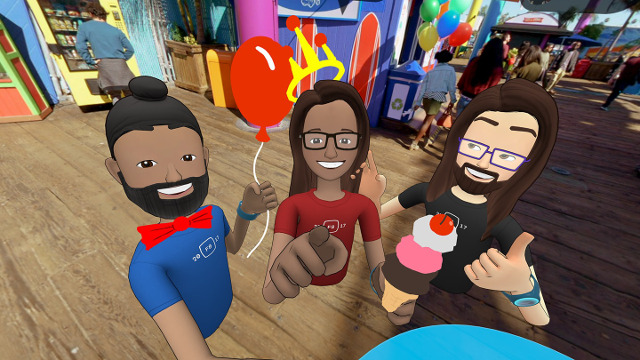There’s something bizarre yet compelling about interacting with other players in VR space. Maybe it’s the thought of engaging with others without any pants on inside the comfort of your own home, or maybe it’s just that seeing a fellow human being represented by a cartoon avatar is something that takes getting used to.
Whatever it is, this week Facebook released a beta of its first very own social VR experience called Facebook Spaces. It’s a big deal given the company acquired Oculus for $2 billion almost three years ago, alluding to social applications. It might not have been ready for the Oculus Rift’s launch, but coming in a year later to bring new attention to the VR market might just have been for the best.
I happened to put down some money on an Oculus Touch a few weeks ago, which is required to play Facebook Spaces. So, the moment I learned of its release yesterday I downloaded its 1.35GB of software and hopped in.
For the first few minutes I spent time customizing my character. Although this would be uneventful in a standard video game, Facebook Spaces loaded real-life images of me from my Facebook profile to compare to the array of options available. It was awfully strange looking at photos of myself in a VR space, but it was useful for defining my facial proportions to be as accurate as possible.
Options ranged from gender to hair, accessories, eyebrows, and just about everything else you’d expect. There was a surprising amount of diversity, ensuring that everyone, no matter their ethnic background, can represent themselves properly within the application.
After trying to make sure my avatar didn’t look too ridiculous, I joined another player’s space. This put both of our avatars in a park surrounded by trees and grass. The environment was actually a real-life 360 degree photo, resulting in a surprising level of realism despite the lack of motion. When fixated on the environment I could tell that it didn’t have the luxury of high clarity, but most of the time I was distracted by my interactions with the other player, and in these circumstances the background provided a believable atmosphere.
I’m not sure what I was expecting, but seeing another player moving around in VR was bizarre. As his head and arms moved, I knew that’s what he was doing in real life, rather than what buttons he was pressing on a controller. When we made eye contact, I knew I had his attention rather than him just positioning his avatar in front of me.
On that note, looking at someone in VR is rather incredible. Usually in a game players adhere to a different ruleset than when speaking with others in real-life, but there’s something different about VR. Speaking with people is more personal, as if you’re enjoying a cup of coffee with them at a cafe. Perhaps more importantly, doing silly things can be embarrassing, so be sure to check where everyone’s attention is before fixing that wedgie or picking your nose.
There are a lot of small details that make these avatars lifelike. Body language is actually expressed in this environment, whether it be through posture or hand movements. You can even see their avatar mouth move when they speak. These subtleties going a long way toward making you want to keep engaging with other people instead of quickly turning your attention to activities.
For all intents and purposes, my experience is that it was like interacting with someone in real life, only we were hundreds of miles apart and engaging in an artificial environment. Actually, I was in my office space, which is about as far away from a park as you can get.

There aren’t a whole lot of things to do in Facebook Spaces, but what is currently included is imaginative. 360 degree photos transported me to incredible locations I’ve never been to before, and drawing 3D objects in a social space made me feel like a kid again. In the case of the drawing tool, a lot can be accomplished with a single pencil than you would probably think; tic-tac-toe, pictionary, or just drawing whatever comes to mind are all within the realm of accessibility, and easily shareable.
There are a few other social VR games available for Oculus Rift, most notably AltspaceVR. Although some will argue that these may be better than Facebook Spaces, the latter has the advantage of having access to Facebook information and features, which is a major contributor to its value.
This is best demonstrated by video call functionality, which allow VR and/or non-VR users to connect. This is something that you can already do without a $600 Oculus Rift solution, but there’s something neat about being able to demonstrate yourself in a VR space. Since you’re embodied by a cartoon character, it’s much more casual and comforting while still retaining the important social qualities that are imperative to a proper video chat experience.
As much as it weirded me out, Facebook Spaces made a great impression on me. Maybe this is just a honeymoon period with new technology, but I get the feeling that there’s huge potential when it comes to social VR environments. I can’t wait to see what comes next.







